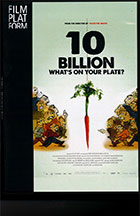
10 Billion: What’s on Your Plate? 2015
Distributed by Film Platform
Produced by Tina Leeb and Jürgen Kleinig
Directed by Valentin Thurn
DVD , color, 102 min.
College - General Adult
Agriculture, Nutrition, Ecology
Date Entered: 08/17/2017
Reviewed by Brandon West, Social Sciences Librarian, State University of New York at GeneseoBy 2050, the world population is estimated to be ten billion people. Director Thurn’s documentary examines one of the major crises this population is predicted to face—the need for food. Current models of food production are not sustainable for most of the world, notably meat production is particularly destructive for the environment. Thurn’s film explores how food production, population, and the need for social justice all play a critical role in ensuring that there will be enough food in the future.
Thurn explores multiple issues impacting food production. He investigates how big corporations’ use of fertilizers and genetically modified plants are not necessarily the solution to the impending food crisis. Rather, Thurn shows how such practices wind up destroying agribusiness for small, local farms. Business decisions like stock market speculation also cause negative consequences for many developing nations. Throughout Thurn’s investigation, he travels around the world to learn how people are coping with food scarcity and farming habits. He observes people using insects as a source of protein and he learns how the University of Maastricht is experimenting with growing artificial meat. The purpose of the film is to illustrate that there are ways to approach sustainable food production that rely on local farming practices rather than large commercial ones.
This film could have easily used scare tactics to pique viewer interest. However, Thurn presents an interesting and well-balanced perspective. This narration of the events and concepts provide ample details, while respecting the intelligence of the audience. The film has an overall high technical and production quality. One small issue is that the font for translated captions was difficult to read at times. This film’s content is appropriate for academic programs about ecology/sustainability, anthropology, sociological issues, geography, and agricultural science. By examining the intersections of food production and social justice, there are deep themes that can be tweezed out in classroom discussions or further research. 10 Billion has many merits that make it a valuable addition to library collections.